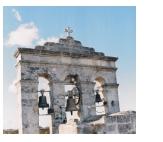The “Fortress” Church of “Maria SS. dell’Immacolata”

The church, built at the end of the XVI century, was first entitled to S. Antonio da Padova. During the XVII century it was enlarged thanks to the endowments of some private citizens.
The compact and huge architecture of this church is strictly related to the history of this region. After the Turks attacked the Salento coasts, the entire territory re-organized its defense by building castles, farm-houses, fortified churches and various watch towers all along the coast.
Following this new logic, the Church in Vignacastrisi, was turned from a religious building into a structure that could also give shelter to the citizens in case of an enemy attack.
The façade has some romanic-style elements and the decorations of the portal, of the window, of the bell-tower and of the internal vaults, remind of the style used for the fortified Churches of the same period.
The Church has one nave and on its vault there is an ornament carved on local stone
The restoration
During the 1948 restoration works the central altar (made of local limestone) was destroyed and changed with the present one in marble.
Also the four side altars were destroyed and partially rebuilt in marble or replaced by the tabernacles with the statues of the saints and then decorated with gold, together with the baptismal font.
In the years after, on the right-hand side of the presbytery it was added the part of the church where some of the believers could be hosted during the most crowded holy masses.
The present marble balcony that divides the presbytery from the rest of the church, was originally made of local limestone and can still be seen above the organ.
 The bells
The bells
Up to some centuries ago, the bells were rung by the bell-ringer.
The biggest ones weighs 72 kgs and is dedicated to S. Domenico and S. Giuseppe while the smallest one weighs 32 kgs and it is dedicated to S. Antonio da Padova and S. Vito.
The present bells are not the original ones. They were given to the church in 1948, since the original ones had been seized, melt and turned into cannons.
The new bells were welcomed by the entire population and they were blessed at the presence of two of the most important citizens of the town: Fabio Bacile, Baron of Castiglione and Lady Enza Guglielmo of Vignacastrisi.
The secrets
In the underground part of the church there were two crypts that, in ancient times, contained the remains of the priests and believers. After the application of Napoleon’s law, the graveyards started to be built outside the city centres and the crypts were abandoned. The only evidence of their existence is the presence of two arches that can still be seen on the external western side of the church.
The last treasures discovered in this church are the baptismal font and the organ, that have been found thanks to the works ordered by the present priest, don Arcangelo Ruggeri. The baptismal font is located on the left of the main entrance and is made of local limestone, carved with flower decorations. The organ dates back to the XIX century and as decorations carved on olive wood. On the top of the structure there is an image of S. FIlippo Neri, the founder of the music lecturers.
The Churc of the “Confraternita del SS. Rosario”
The church was built in 1926 on an altar dating back to the XVIII century.
The façade has romanic elements and the internal nave is covered with a flat roof made of iron and limestone beams.
The citizens’ contribution
In 1958 it was necessary to restore the roof, whose beams had been damaged by oxidation. The master-builders of the town re-built the roof using the local limestone and giving it the typical edged shape.
The works were financed by the entire population, starting from the mayor “Don Pippi” Guglielmo and the priest. Another contribution was necessary to restore the statue of the “Madonna del Rosario”, that had been damaged during the fire that burnt the church in 1962.
The main altar has a particular history. It was built by the Coppola’s brothers, master-builders of the town that personally built the altar in their free time and eventually donated it to the confraternity.
The Calvary
Next to the church there is a Calvary, which is a typical religious building in Salento and that was probably built together with the church of the Confraternity.
This buildings were used for the public prayer and have different shapes.
The Calvary in Vignacastrisi was built with an apse and the frescoes belong to the maestro Alessandro Bortone by Diso.
